This was published 1 year ago
‘Part of this conspiracy’: The Australian journalist at the centre of the Trump trial
This article has been republished after a jury found former US president Donald Trump guilty on all 34 counts in his hush money trial in New York.
By Kate McClymont and Cameron Houston
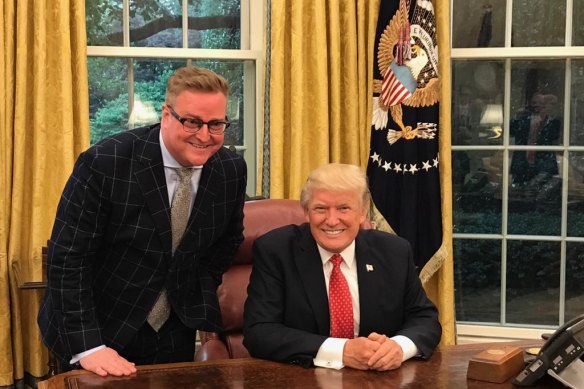
Dylan Howard with then-president Donald Trump in the Oval Office in 2017.
Wearing a dapper checked suit and gold tie, and looking much older than his 35 years, Dylan Howard rests his pudgy right hand on the presidential desk in the Oval Office as he and President Donald Trump beam for the camera.
It’s July 11, 2017, and Howard, Australia’s most infamous tabloid journalist, along with his boss at the National Enquirer, David Pecker, had been invited to dinner at the White House as a “thank you” for their repeated acts of unethical journalism, which had helped cover up any embarrassing stories which might have impeded Trump’s win at the November 2016 election.
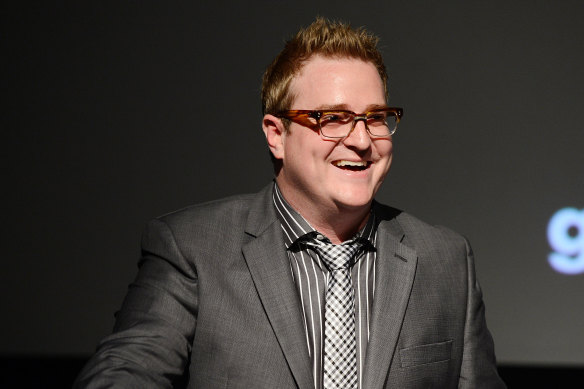
Dylan Howard at a function in Los Angeles in 2012.Credit: WireImage
In recent weeks, a jury at the criminal trial of former president Trump has heard much about Howard’s unfortunate role in perfecting the dark art of “catch and kill”, where stories which could have damaged Trump’s chances of becoming president in 2016 were bought and buried.
“We have elicited sufficient testimony to conclude prima facie that Dylan Howard is a member of the conspiracy,” said prosecutor Joshua Steinglass. Judge Juan Merchan agreed, saying it was established that Howard “was part of this conspiracy”.
While Howard’s actions have been central to the trial – during just one day in the witness box, Pecker mentioned Howard’s name more than 100 times – the tabloid journalist has been noticeably absent, playing the role of Banquo’s ghost from an unknown location in Australia.
Pecker told the jury: “From what I heard, is that he right now has a spinal condition”, making it impossible for him to travel to New York to give evidence.

Donald Trump, Stormy Daniels, Dylan Howard, and David Pecker (lower right).Credit: Bethany Rae
His American lawyer, John Harris, has previously said: “Dylan Howard has always fully co-operated with government inquiries regarding his former employer’s relationship with Donald Trump, and the actions he was directed to do. But for Mr Howard’s inability to travel, he would have again, voluntarily, answered questions.”
The Manhattan court has heard that Trump relied on the services of Howard and Pecker, his boss at one of the United States’ largest media companies, American Media Inc (AMI), the publisher of the National Enquirer, a magazine featuring a rotation of barely credible Hollywood gossip, UFO abductions and bizarre medical ailments.
While the trial has been in progress, Howard, 42, has been keeping an uncharacteristically low profile. “If he doesn’t want to be found, you won’t find him. He knows every trick in the book,” said a former colleague, who added that his former workmate “would be harder to find than a snow leopard”.
However, there have been sightings of Howard at the most expensive house in the sleepy seaside town of Lorne, in Victoria. Neighbours confirmed seeing Howard more than a fortnight ago, leaving what has been described as “a private resort-like compound” to walk a small fluffy white dog.
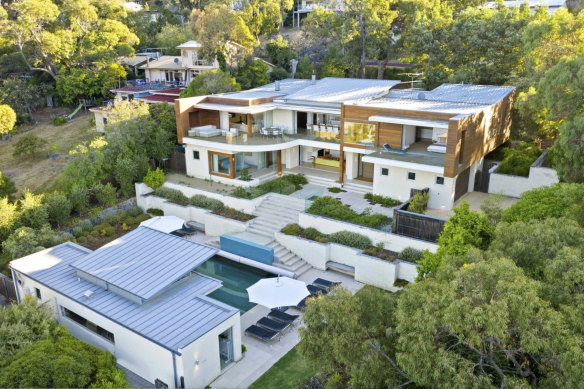
The property Dylan Howard has been staying at in Lorne. His mother, Judith Howard, bought it for $7.25 million in January 2020.
A tradesman working near the six-bedroom $7.25 million property, purchased by Howard’s mother, Judith, in January 2020, has also claimed to have seen the evasive media mogul walking a white dog around the exclusive coastal town about 140 kilometres west of Melbourne.
But there was no response when this masthead buzzed at the security gates, other than a dog barking inside the home.
Howard returned to Melbourne after his departure from AMI in March 2020, which also coincided with a probe by federal investigators in the US over his role in the hush-money plot to get Trump into the White House. Howard has not been charged but features as a key player.
As the votes for the presidential election were being counted in November 2016, Howard texted his mother in Geelong. “He’s in with a massive chance,” he says of Trump. In another text, Howard writes: “At least, if he wins, I’ll be pardoned for electoral fraud.”
Later in the evening, Howard texts, “He’s just been named President Elect”, to which his mother responds: “Oh, dear.”
Once Trump was in office, he organised a dinner at the White House to thank Pecker and AMI for killing stories which could have had a catastrophic effect on his election chances.
“Pecker brought his eyes and ears, Dylan Howard from the National Enquirer, to that dinner,” prosecutor Matthew Colangelo told the jury.
Not only did Howard and Pecker “catch and kill” unfavourable stories for Trump but Trump’s then-lawyer, Michael Cohen, would indicate to them which potential rivals of Trump should feature in adverse articles published in the National Enquirer.
Pecker told the court that it was Howard who had alerted Cohen to the potentially explosive story about porn star Stormy Daniels’ tryst with Trump. As it was only days out from the presidential election, Cohen said he personally paid “hush money” to Daniels to kill the story.
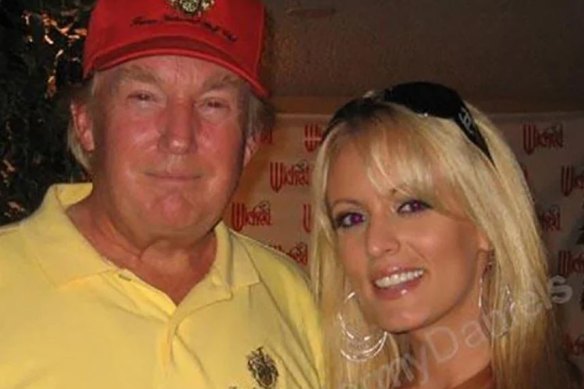
Donald Trump and Stormy Daniels in 2006. He was 60, she was 27. He is accused of falsifying business records to hide a hush-money payment to her.Credit: MySpace.com/StormyDaniels
Trump is alleged to have subsequently reimbursed Cohen, falsely claiming the payments were for legal expenses. In doing so, Trump allegedly committed the crime of falsifying business records.
“It was election fraud. Pure and simple,” Colangelo told the jury in his opening address.
The scandal involving AMI’s role in the Trump case is not Howard’s first brush with infamy.
In early March 2018, lawyers acting for Howard, the young Australian then at the helm of America’s grubbiest tabloid newspaper, fired off a threatening legal letter to executives at Channel Nine.
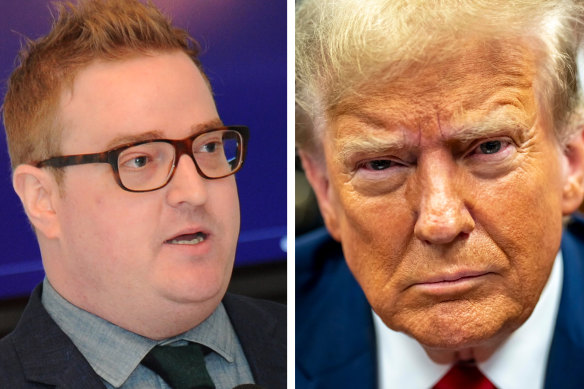
Dylan Howard, a former Channel Seven reporter pictured here in 2014, made a career for himself in the US tabloid industry. Former president Donald Trump sits in a Manhattan courtroom.Credit: Getty Images/AP
“Our clients are of the opinion that this is gutter journalism at its very worst, and it is shameful that 60 Minutes abandons any [sic] its ethical principles in an attempt to increase its ratings for purely financial gains.”
Reporter Liam Bartlett and the 60 Minutes crew had followed Howard into AMI’s headquarters in New York Plaza.
As he entered the office block, Bartlett peppered Howard with questions about whether he had played a role in helping Hollywood mogul Harvey Weinstein bury allegations of his serial sexual predation.
Despite Howard’s lawyers threatening to sue 60 Minutes for trespass and defamation, a week later the program aired allegations about Howard and AMI’s role in what has now become known as “catch and kill”, the tawdry practice of paying for stories, only to kill them off for the benefit of high-profile people like Weinstein.
But since swapping Manhattan for Melbourne, Howard has maintained a low profile.
After the start of Trump’s trial, Howard removed his private Instagram account, along with a profile on the online dating site Hinge that listed his simple pleasures as a “dirty vodka martini and laughs at the bar”.
Born in January 1982, Howard studied journalism at RMIT in Melbourne in 2000 before transferring to Deakin University in his home town of Geelong.
Three former RMIT students, who asked not to be identified because of concerns of legal retaliation by Howard, all commented on his ambition and drive.
“Look, he was a fun bloke to hang out with and we’d often catch up for beers. But he was just so f---ing ambitious,” a former RMIT student said.
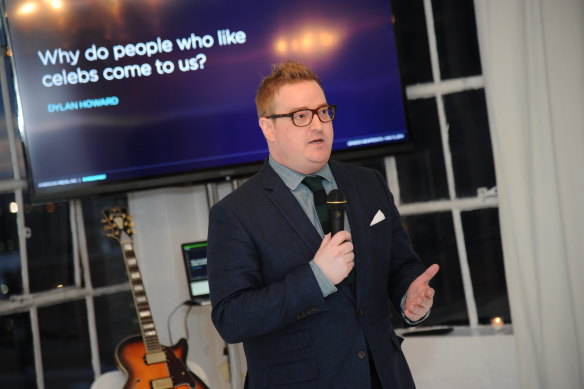
Howard in New York in 2014.Credit: Getty Images
Another student said Howard had “bullet-proof confidence”.
“At uni, you’d find yourself wondering who would end up getting a job because it was obviously competitive, but there were never any doubts for him,” the former student said.
Howard landed his first job at the Geelong Advertiser, eventually reporting on the AFL in a town with just one team and a massive appetite for footy news.
Colleagues at the News Limited-owned paper made similar observations about the cub reporter.
“He seemed desperate to be the next Eddie McGuire [media personality and AFL commentator]. Always impeccably dressed and always trying to ingratiate himself in the right circles,” one former subeditor said.
Within a few years, Howard got his big break with Channel Seven and made the move to Melbourne.
He landed a series of scoops in the rough-and-tumble world of AFL reporting, which can be almost as ruthless as the game itself.
Dressed more like a corporate banker than a reporter, Howard’s image was used to promote the network’s AFL coverage and Good Friday Appeal, while he regularly anchored the sports bulletin on the weekend news.
However, Howard raised the ire of the then AFL boss, Andrew Demetriou, over a story in which he accused a West Coast Eagles player of taking performance-enhancing drugs.
But relations between the host broadcaster and the league soured dramatically when Howard broadcast an exclusive story in 2007, revealing confidential details of illicit drug use by two unnamed players and their subsequent counselling.
Demetriou described the story as “abhorrent”, while several clubs and the players’ association threatened a boycott of player interviews and attendance at the Brownlow Medal count. As Channel Seven was the official broadcaster, this could have been commercially damaging.
Never one to take a backward step, Howard accused Demetriou of censorship in an opinion piece published in the Geelong Advertiser, while also claiming the AFL had acted like “vicious political animals”.
However, the story was based on medical files found by a couple on a street in Ivanhoe, in Melbourne’s north-east, which resulted in Robert Crouch and Catherine Mitchell pleading guilty to theft in August 2008.
They told the Heidelberg Magistrates’ Court they had been contacted by Howard, who handed over $300 for the files with the promise of a further $2700.
Although Howard was never charged and he and the network were eventually cleared of any wrongdoing by police in November 2008, he was told to “empty his desk” by then-news director Steve Carey.
Ten years ago, Geelong-based freelance reporter Noel Murphy chronicled Howard’s subsequent meteoric rise in the world of US tabloid journalism after being “run out of Australia”.
“He’s broken stories such as Charlie Sheen’s urine sample in a massive exclusive that ran worldwide, tangled with Lindsay Lohan over stories, and had a toenail-painted pig rush him in Paris Hilton’s home,” wrote Murphy.
“Right now, Howard is king of the hill, top of the heap, in old New York … And he’s understandably serious about the business of celebrity,” wrote the freelancer.
Howard has previously told Bloomberg: “We do good old-fashioned boots-on-the-ground reporting that much of the mainstream media doesn’t do today. My chequebook is big, and it is open.”
While Howard’s role in the sordid Trump scandal may have diminished his standing, it has not stopped him from pursuing his extensive US media interests from afar.
His company struck a deal to publish Grazia fashion magazine franchise in the US. Howard, who owns a house in the Hamptons, has launched Grazia Gazette: The Hamptons which is described as “the newest and most exciting incarnation of the world’s premier style and cultural authority”.
Renowned for his ferocious work ethic, Howard has pitched true-crime documentaries and podcasts to local producers, including a potential series on the murder of child beauty queen JonBenet Ramsey.
In March 2022, Howard founded the Pantheon Brands and Media Group, which lists him as the sole shareholder, while his father, John Howard, is the sole director, according to corporate records.
Howard’s company, which last week changed its name to Mystify Group Pty Ltd, lists its principal place of business at an address in Geelong, which also houses the Howard family’s business, Ikon Collectables, which distributes popular culture merchandise including action figures, key rings, comics and games.
There were no signs of the elusive tabloid editor when this masthead visited the Howard family’s business headquarters in the Geelong suburb of North Shore.
Another property in Newtown registered in his mother’s name also appeared unoccupied, as did a property in Highton, also owned by his mother, which Howard listed as his address before his move to the US in 2009.
Howard’s one-bedroom apartment in St Kilda Road, which he bought for $410,000 in 2008, has been rented since purchase.
Howard’s brother and father did not respond to calls from this masthead, while calls to the family business also went unanswered.
Even his publicist, Lainie Coombes, was unaware of Howard’s location.
“I haven’t spoken to Dylan in weeks, but I’ll try and track him down,” she said.
Get a note directly from our foreign correspondents on what’s making headlines around the world. Sign up for our weekly What in the World newsletter.
clarification
This story has been updated to make it clear the Highton property is owned by Dylan Howard’s mother. Details about Howard’s ownership of a St Kilda Road apartment have also been added.